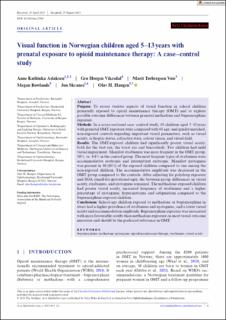| dc.contributor.author | Aslaksen, Anne Kathinka | |
| dc.contributor.author | Vikesdal, Gro Horgen | |
| dc.contributor.author | Voie, Marit Torbergsen | |
| dc.contributor.author | Rowlands, Megan | |
| dc.contributor.author | Skranes, Jon Sverre | |
| dc.contributor.author | Haugen, Olav H. | |
| dc.date.accessioned | 2023-10-05T07:17:06Z | |
| dc.date.available | 2023-10-05T07:17:06Z | |
| dc.date.created | 2023-09-27T12:44:52Z | |
| dc.date.issued | 2023 | |
| dc.identifier.citation | Aslaksen, A. K., Vikesdal, G. H., Voie, M. T., Rowlands, M., Skranes, J. & Haugen, O. H. (2023). Visual function in Norwegian children aged 5–13 years with prenatal exposure to opioid maintenance therapy: A case–control study. Acta Ophthalmologica, 1-12. | en_US |
| dc.identifier.issn | 1755-375X | |
| dc.identifier.uri | https://hdl.handle.net/11250/3094332 | |
| dc.description.abstract | Purpose: To assess various aspects of visual function in school children prenatally exposed to opioid maintenance therapy (OMT) and to explore possible outcome differences between prenatal methadone and buprenorphine exposure.
Methods: In a cross-sectional case–control study, 63 children aged 5–13 years with prenatal OMT exposure were compared with 63 age- and gender-matched, non-exposed controls regarding important visual parameters, such as visual acuity, orthoptic status, refractive state, colour vision, and visual field.
Results: The OMT-exposed children had significantly poorer visual acuity, both for the best eye, the worst eye and binocularly. Two children had mild visual impairment. Manifest strabismus was more frequent in the OMT group, 30%, vs. 4.8% in the control group. The most frequent types of strabismus were accommodative esotropia and intermittent exotropia. Manifest nystagmus was present in 10 (16%) of the exposed children compared to one among the non-exposed children. The accommodative amplitude was decreased in the OMT group compared to the controls. After adjusting for polydrug exposure and SGA (small-for-gestational-age), the between-group differences in visual acuity, strabismus, and nystagmus remained. The methadone-exposed children had poorer visual acuity, increased frequency of strabismus and a higher percentage of nystagmus, hypermetropia and astigmatism compared to the buprenorphine-exposed children.
Conclusions: School-age children exposed to methadone or buprenorphine in utero had a higher prevalence of strabismus and nystagmus, and a lower visual acuity and accommodation amplitude. Buprenorphine exposure was associated with more favourable results than methadone exposure on most visual outcome measures and should be the preferred substance in OMT. | en_US |
| dc.language.iso | eng | en_US |
| dc.rights | Navngivelse 4.0 Internasjonal | * |
| dc.rights.uri | http://creativecommons.org/licenses/by/4.0/deed.no | * |
| dc.title | Visual function in Norwegian children aged 5–13 years with prenatal exposure to opioid maintenance therapy: A case–control study | en_US |
| dc.type | Peer reviewed | en_US |
| dc.type | Journal article | en_US |
| dc.description.version | publishedVersion | en_US |
| dc.rights.holder | © 2023 The Authors. | en_US |
| dc.source.journal | Acta Ophthalmologica | en_US |
| dc.identifier.doi | https://doi.org/10.1111/aos.15764 | |
| dc.identifier.cristin | 2179390 | |
| cristin.ispublished | true | |
| cristin.fulltext | original | |
| cristin.qualitycode | 1 | |

